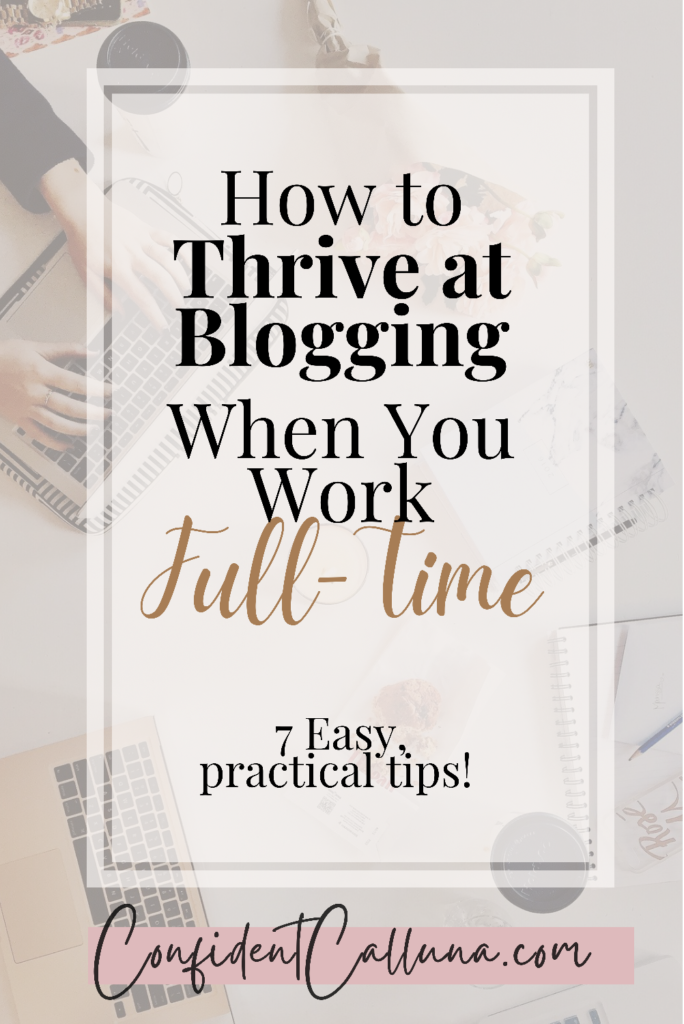
How To Succeed As A New Blogger And Avoid Burnout
This article will discuss ways to excel as a new blogger and tips to avoid blogger burnout in your first year.

Starting my blog was one of the most exhilarating, happiest experiences of my life. Creativity flowed easily. New ideas flooded my mind all day long. I would create several months’ worth of content in under two hours.
As exciting as this newness was, realizing how much actual work went into running a blog set in quickly. As a new blogger, YOU are your entire team. That means juggling being a writer, a social media manager, a website developer, and a creative director. Can you relate?
When your potential reader finally lands on your blog post, they see 1,000+ words written for their viewing pleasure, but what they do not see is the work behind it. You have spent time brainstorming, researching your topic and applicable SEO keywords, writing and editing the actual article, formatting it for your website, adding/creating images for your post, and lastly, marketing on social media platforms.
The process of publishing a new article is cumbersome, so it is no wonder that many new bloggers quit in their first year. It sure can be discouraging to put so much work into your blog and feel depleted creatively.
BUT at the root of it all, I am an optimist, and I will ALWAYS choose to see the silver lining. So what if I told you there was a fool-proof way to excel at blogging and avoid burnout? I am a firm believer in having your cake and eating it, too. And I believe new bloggers can maintain and evolve creatively while having long-term success.
Here are 4 ways to avoid burnout as a blogger:
Optimize old content
I once read that every new blogger’s article will suck when they start. I refused to claim this truth until I went back to re-read my first few posts and determined that they were indeed correct. We will ALL have a few old articles that can use a little extra love.
Think of optimizing old content as remodeling an old house. It has a good foundation, and it just needs a few renovations before being put back up on the market.
A few ways to optimize old content is to:
-
- Make it SEO-friendly. Challenge yourself to research and include more SEO keywords so that your article will rank higher in search engines on Google/Bing and Pinterest. You would be surprised how a few added words can transform your articles. If you’re new to learning SEO, I highly suggest reading The Sassy Way to Ranking #1 in Google – when you have NO CLUE!: A Beginner’s Guide to Search Engine Optimization to gain a better knowledge. This will save you from the trap of creating content that does not reach the end user. Burnout is inevitable when you feel you are spending time creating without reaching an audience.
- Increase your word count. Having more words in your article means a better opportunity for your website to rank higher in search engines. Additionally, adding more words means you are increasing the effectiveness of your post. Include a few updates if you have discovered more relevant knowledge or insight that would be valuable to your readers.
- Reformat old articles. As you grow as a blogger, your website style and format will evolve. Do a quick clean-up of older articles, give them fresh images, and re-release them to your readers.
Please note that this page contains affiliate links. See my full disclosure here.
Optimizing old content also allows you to introduce helpful and interesting content to new readers. You will pick up new subscribers along the way that may not have seen your older content.
Most importantly, revisiting past articles allows you to have a break creatively.
Create content in batches
Creativity as a blogger will ebb and flow. When you feel your creativity flowing, use that momentum to brainstorm blog ideas that you can research and write later.
If you are a blogger that creates visual content (YouTubers, fashion bloggers, food bloggers, etc.), try to carve out a few hours to record and take pictures for future posts.
Change your background/scenery, have a few outfit swaps, and make the magic happen. Your future self will be thankful for having pictures and videos readily available. AND you will not be bogged down by yet another step in your process.
If your blog requires written content, write as many articles as you can when you feel motivated, and resist the urge to publish all articles at once! Save your fresh content and release them in phases. I will talk about this more in #3!
Have a content plan
Have you ever heard the phrase, if you fail to plan, you are planning to fail? No truer words could ever exist in the blogging world. Having a content plan gives you a clear roadmap for when/what you will be creating/publishing and a timeline for clean execution.
Content planning allows you to produce new, fresh content consistently, and you can also find areas where you can take a break. For example, I aim to release four new articles per month on Fridays. If a month has five Fridays, I allow it to be a by-week and do not upload a new article for one week out of the month.
Additionally, your content calendar should include release dates for every article written. This provides you with a visualization of the content you are posting so you know which weeks you can optimize older content without it being too early to recycle it to your readers.
Be sure to study your analytics and consider them when you are content planning. For my website, my analytics show that users are not as active on my website during big holidays. I usually refrain from releasing content those days/weeks to give myself a break to be more present with my loved ones.
If you are not subscribed to my list yet, make sure to sign up to get your FREE content planning template. I also specialize in helping new bloggers in their journey, so be sure to check out my Beginners Blogger Course that includes a one-hour one-on-one session to discuss content planning and other topics of your choice to help you find success.
Take a break when needed
More often than not, you started this blog to do something you love without the confines of a traditional 9 to 5 job, or because you have a limited schedule and need to generate a second income, or simply because you want to do something you love.
Allow yourself to take a break when needed so that you do not burn out creatively. It is much easier to take a two-week hiatus than to quit on your readers/viewers cold turkey and return months later.
Remember, long-term blogging is building a relationship with your audience and growing together over time. Should you decide to take a long-term hiatus, let your readers know in a quick email note and suggest similar blogs that you think would pique their interest.
Conclusion
This is YOUR journey, and you will find your success if you make even a little progress each day. Running your blog and watching it flourish is one of the most rewarding experiences. To stay on track and avoid burnout along the way, be sure to optimize old content, batch create content, have a solid content plan in place, and take breaks when needed. Which tip do you think will be most helpful for YOUR journey?
For more tips and tricks on how to be the BEST version of you, click here to stay in the loop!


You May Also Like

15 Thought-Provoking Journal Prompts
December 13, 2020
How to Thrive and Live a Well-Balanced Life
December 18, 2020

